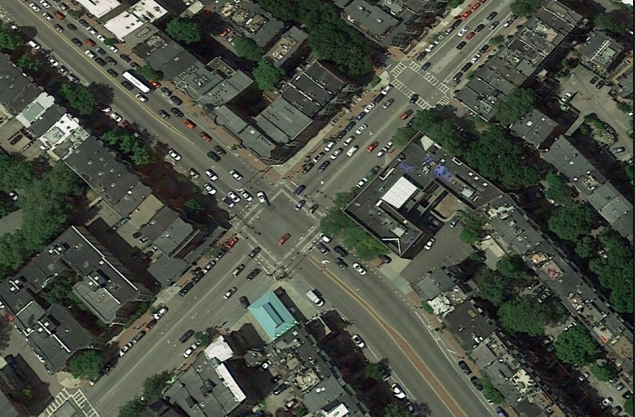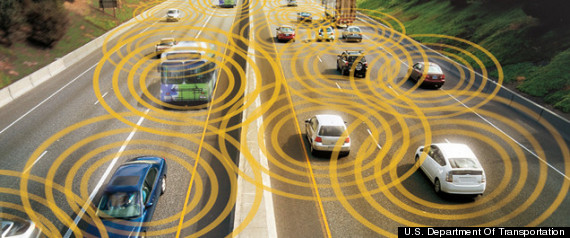When slower is faster: how to get rid of traffic lights
March 18, 2016

Intersection congestion (credit: Google Earth)
Traffic-light-free transportation design, if it ever arrives, could allow twice as much traffic to use the roads, according to a newly published open-access study in PLoS One co-authored by MIT researchers.
The idea is based on future vehicles equipped with the kind of sensors used in autonomous vehicles and that communicate wirelessly with each other, rather than grinding to a halt at traffic lights.
The researchers created a mathematical model based on a scenario in which high-tech vehicles use sensors to remain at a safe distance from each other as they move through a four-way intersection. By removing the waits caused by traffic lights, these new “Slot-based Intersections” (SIs) speed up traffic flow in the model.
MIT Senseable City Lab | Light Traffic | MIT Senseable City Lab
The greater capacity of the system, notes Paolo Santi, a researcher in the MIT SENSEable City Lab (a member of the Italian National Research Council and a co-author of the study), does not stem from vehicles moving more quickly. Rather, it comes from creating a more consistent flow at an optimal middle speed, at which automobiles can keep moving. “You want the car to use the intersection for the shortest possible time,” Santi says.
Such a system would also reduce pollution and save on gasoline.
The “slower is faster” effect
To see why the system could at least work in theory, consider what the researchers call the “slower is faster” effect. When passengers board an airplane, they tend to move faster if they are in smaller clusters that keep going steadily, as opposed to a scenario in which everyone crowds around the entrance, creating a giant bottleneck.
“If you need to slow down the vehicles because there is a lot of traffic,” says Santi, “you slow them down early in the road, so they approach the intersection at slow speed, but then when they cross, you use the best speed.”
By “early,” Santi means that control of intelligent vehicles in the proposed system would occur not just at intersections but on the road segments leading to them. The modeling in the paper also finds that the most efficient traffic flow puts vehicles together in batches — like those smaller groups of passengers boarding a plane — and then slides them through the intersection accordingly.
The authors noted that in many cities, intersections with lights are often placed relatively close to each other. So how would the dynamics of traffic at one intersection propagate through a whole urban network of roads? They’re working on that.
A previous study with the same idea, but based on driverless vehicles, was done at Virginia Tech Transportation Research (see “Driverless vehicles to zip at full speed through intersections“).
Vehicle communication systems

So exactly how would this work? The authors suggest that vehicles might communicate with roadside infrastructure and other vehicles to produce better coordinated flows. The notion of a vehicle-to-vehicle (V2V) communication system has been studied fairly extensively (see “V2V: Department of Transportation’s new communication system helps cars avoid crashes by talking to each other” and “A 3,000-vehicle test of wireless crash-avoidance system“) but has been criticized as hackable.
Abstract of Revisiting Street Intersections Using Slot-Based Systems
Since their appearance at the end of the 19th century, traffic lights have been the primary mode of granting access to road intersections. Today, this centuries-old technology is challenged by advances in intelligent transportation, which are opening the way to new solutions built upon slot-based systems similar to those commonly used in aerial traffic: what we call Slot-based Intersections (SIs). Despite simulation-based evidence of the potential benefits of SIs, a comprehensive, analytical framework to compare their relative performance with traffic lights is still lacking. Here, we develop such a framework. We approach the problem in a novel way, by generalizing classical queuing theory. Having defined safety conditions, we characterize capacity and delay of SIs. In the 2-road crossing configuration, we provide a capacity-optimal SI management system. For arbitrary intersection configurations, near-optimal solutions are developed. Results theoretically show that transitioning from a traffic light system to SI has the potential of doubling capacity and significantly reducing delays. This suggests a reduction of non-linear dynamics induced by intersection bottlenecks, with positive impact on the road network. Such findings can provide transportation engineers and planners with crucial insights as they prepare to manage the transition towards a more intelligent transportation infrastructure in cities.